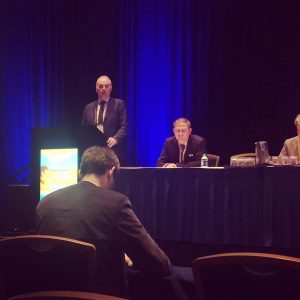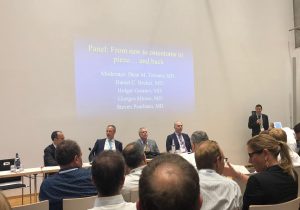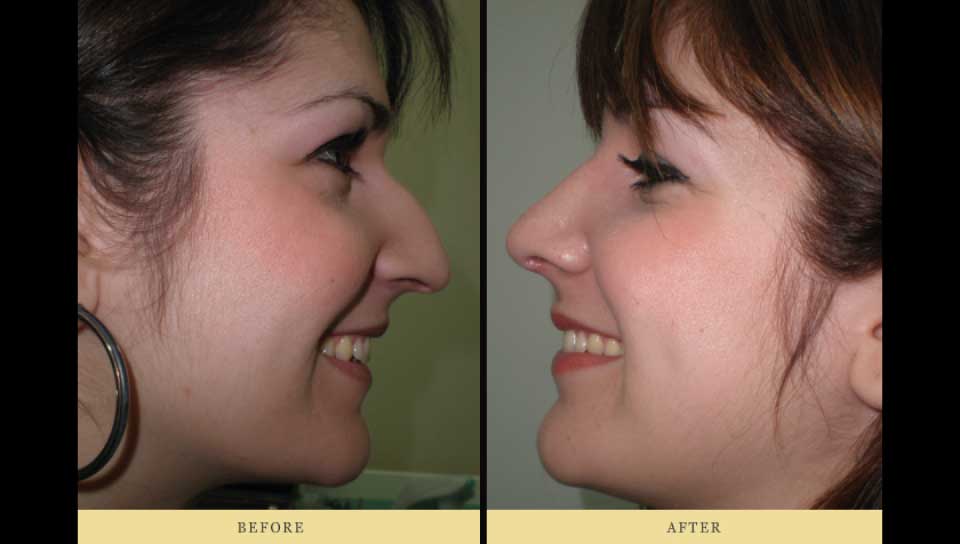Diamond Rhinoplasty – Piezo Rhinoplasty
The new Ultrasonic – Piezo technique allows the surgeon to modify the nose with rhinosculpture rather than breaking it with osteotomes
What is Piezo Rhinoplasty?
Piezo is a system that transforms electrical energy into ultrasound, enabling the surgeon to make real “sculpting” in the nasal bones, altering their shape and thickness as needed, and even cutting them if required, without creating any problem to other sensitive nose tissues.
Piezo uses ultrasonic vibrations at a frequency of 25-29 kHz to change bone shape while leaving all soft tissues that are affected at frequencies above 50 kHz such as skin, mucous membranes, vessels and nerves completely intact.
Piezo’s technology has been known for several years and is mainly used in dentistry with excellent results in the management of the upper and lower jaw bone.
Due to the fact that there is not enough space in the area of the nose and the classic microtips could not be used, there was a long delay in the application of Piezo to rhinoplasty.
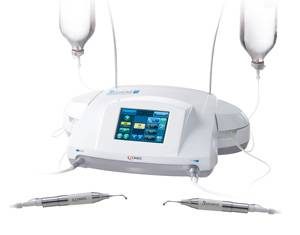 |
 |
| Piezotome Dual+ | Piezo rhinoplasty microtips |
The revolutionary technique, Dr. Mireas expertise and Greece’s representation Worldwide
In 2013, with the creation of a series of special microtips tailored specifically to the needs of a rhinoplasty, the application and development of the system by the world-renowned rhinoplasts such as Olivier Gerbault (France) and Milos Kovacevic (Germany) began very vigorously.
Dr. Mireas was trained by these two pioneers of the system at Paris and Hamburg and finally become the Greek Expert in Ultrasonic Surgery at 2017
 |
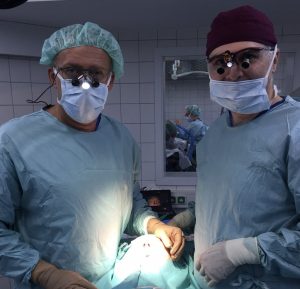 |
|
Dr. Olivier Gerbault & Dr. Mireas Surgery room. Paris 2018 |
Dr. Milos Kovacevic & Dr. Mireas Surgery room. Hamburg 2017 |
Nowadays Piezo is considered to be the most sophisticated system that can be used in nose surgery, providing surgeons with a lot more possibilities, with greater safety and absolute control of the surgical site.
This is why Dr. Mireas exclusively uses piezo system to all the surgeries he performs since 2017
Recognized as an Expert in ultrasonic rhinoplasty, Dr. Mireas makes numerous presentations as Invited speaker at the most re-known International Congresses and Meetings globally
The old techniques and their disadvantages
In the past
Patients who were interested in rhinoplasty have always feared that they should “break the nasal bones” during surgery. The classic surgical kits that have been used for more than a century include essentially the same surgical tools with small variations and improvements. In the bone skeleton of the nose, the basic tools of the surgeon are the osteotomes and the “rasps” .
The goals of the surgeon were as follows:
- To lower the hump
- Break the bones and move them in order to make the nose thinner or to bring it in a more straight position .
- Many times, however, the results with the use of these tools have been satisfactory, but in a significant proportion of the surgeries the bones do not break exactly at the point or the straight line that the surgeon wants, causing small or large malformations, even breathing problems.
- Also, there was no possibility of reducing the thickness of the bone itself, but only moving it in total to make thinner the nose while there was always a “mystery” on the bone skeleton because the surgeon had no direct eyesight especially on the sides of the nose even when the surgery was done with open approach.
Piezo’s advantages and why is considered to be the future of rhinoplasty?
 |
| Natural result |
With Piezo we work completely differently and the patient now knows for sure that:
- We make “sculpture” in the bones
- “We’re removing” the hump
- We form the bones just as we want, even in very intense asymmetries
- We make thinner the bones to the side
- Thus, we make thinner the nose without eventually requiring osteotomies in many cases
- If we want even more narrowing, then with the Piezo we cut the bones in order to move all of them towards the middle line
- Everything is done under direct vision and full control
- Everything is done without causing any damage to the skin, mucous membranes and other soft nose tissues
- Bumps and swelling are less
- The postoperative course is lighter and certainly painless
Revision rhinoplasties – Today
Particularly in re-operations where there was a very serious history and the decision to take a new intervention was very difficult, things are much better because:
- We can handle the “wrong” connected bones with absolute precision.
- We can easily format even “mobile” bones.
- We can also intervene in cases where there is a very recent injury and great distortion due to many and asymmetric fractures.
Why Rhinoplasty with Piezo is so revolutionary for Surgeons
Piezo gives excellent solutions to major problems that the nose plastic surgeon had to face
- The surgeon can now see the bone he wants to shape.
- He fully controls how much hub (hump) will remove
- He thoroughly monitors the bone attenuation it wants to bring to normal
- He can now make thinner the nasal bones directly, especially in patients who have a very “heavy and thick” nasal skeleton
- He can easily handle even moving bones after a recent injury or after some “osteotomy” which did not just happen where it should
- He can feel comfortable and safe that he will not injure the soft molecules of the area such as skin, mucous membranes, etc. because the piezo affects only the bones
- He can do longer if he wants the lateral osteotomy just at the point where he wants because the osteotomy is now made by direct vision rather than “blind”
- He can do “sculpting” now even in moving bones, eliminating asymmetries and abnormalities that would previously has been impossible
- Particularly in reoperations, the surgeon can intervene safely and accurately without the risk of an osteotomy leading to a wrong course as before
Book your appointment now
Please contact our call center at (+30) 210–7526900.
Email us at: info@exelixismedical.gr or georgios.ent@gmail.com
Do upload your requests or questions by completing our form.
Rate this article
Share the page


